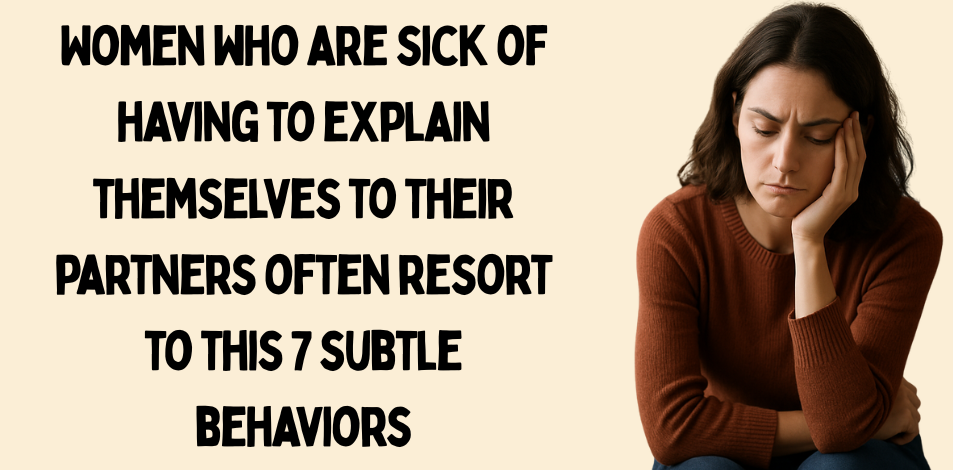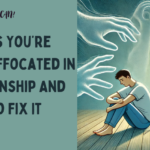
Dealing with the complexities of relationships can be a complex task. For women, especially those who constantly find themselves having to justify their actions or decisions to their partners, it can be even more challenging.
Sometimes, it’s not about getting the other person to understand your point of view, but rather about creating an environment that fosters mutual understanding and respect. This is where tact comes in.
Many women have developed subtle behaviors as a way to express their frustrations without having to confront their partners directly.
They’ve found these strategies to be more effective and less stressful than constantly explaining themselves.
Here are seven subtle behaviors often used by women who are tired of repeatedly explaining themselves to their partners.
While these behaviors may not completely replace an honest conversation, they certainly facilitate the journey to understanding.
1) Silence speaks volumes
Silence is often underestimated, but it can be a powerful communication tool.
Usually, when we think of communication, we think of words. We express our thoughts, feelings, and opinions verbally or in writing. But what if words are no longer effective? What if they are met with resistance, misunderstanding, or disregard?
This is a common dilemma faced by many women who constantly find themselves having to explain their actions or feelings to their partners. After a while, it can feel like you’re going around in circles.
This is where silence comes in. It’s not about ignoring or dismissing your partner, but rather creating space for reflection and understanding.
Choosing not to engage in a repetitive cycle of explanations, women often resort to silence as a subtle way to express their frustration. It’s a message that says, “I’m tired of explaining myself.”
This silent signal can prompt a partner to reflect on their behavior and perhaps realize that their constant demand for explanations is causing them distress.
It’s a subtle behavior that can shift the course of a relationship toward greater understanding and less insistence on justification. And all of this is achieved without a single word being spoken.
2) Focus on actions over words
Sometimes, it’s not enough to just tell someone how you feel; you have to show them. I’ve personally found this to be an effective strategy in my relationship.
I remember a time when I felt overwhelmed by work and responsibilities. My partner would often ask me what I was going through, but none of my explanations truly captured my stress level.
Instead of continuing to explain myself, I decided to let my actions do the talking. I started saying “no” to extra tasks, prioritizing self-care activities like yoga and meditation, and explicitly taking time for myself.
I stopped trying to put into words what I was going through and instead showed him the steps I was taking to manage my stress.
He quickly began to understand the seriousness of what I was going through. He noticed the changes in my routine, my focus on self-care, and my refusal to overwork myself.
The change didn’t happen overnight, but over time, he began to understand my actions and reflect them in his own way. He’s become more supportive of me making time for myself, and he’s even started taking on more household responsibilities.
3) Using Body Language to Communicate Messages
Body language is a very powerful tool. In fact, research suggests that up to 55% of communication is nonverbal, meaning that body language, facial expressions, and tone of voice often speak louder than words.
Women who are tired of explaining themselves to their partners often shift their communication to this nonverbal realm. A simple change in posture, a certain look, or even the way they move around their partner can send clear signals of discomfort or dissatisfaction.
For example, a woman might cross her arms during a conversation to subtly convey defensiveness or a closed-off feeling. Or she might maintain minimal eye contact to show disinterest or detachment.
These simple behavioral changes can be a more effective way to communicate feelings than words alone. They don’t involve direct confrontation or a lengthy explanation, but they can significantly impact the communication dynamics in a relationship.
4) Prioritize Self-Care
When words fail, actions speak louder. For women who are tired of justifying themselves to their partners, prioritizing self-care can become a subtle form of communication.
Instead of explaining why they’re upset or stressed, these women may choose to invest their time and energy in activities that enhance their mental health.
This could be anything from running, enjoying a quiet meditation session, or pursuing a favorite hobby.
This subtle behavior serves multiple purposes. First, it allows a woman to focus on her own needs and well-being. Second, it sends a clear message to her partner that she values herself enough to put his needs first.
In this way, a woman can delicately express her frustrations without having to express them explicitly. Over time, this pattern can impact the dynamics of a relationship, encouraging a partner to be more understanding and less demanding.
5) Setting Boundaries
I went through a period in my life where I felt constantly on the defensive. My partner questioned my decisions, my choices, and even my feelings. It was exhausting and frustrating.
So, I decided to set some boundaries. It wasn’t easy, and it certainly wasn’t something I’d ever done before. But it was necessary.
I started gradually, asserting myself in small steps. If he asked me why I didn’t want to go out with him and his friends, I would simply say I needed some time for myself.
If he criticized my decision to take a yoga class instead of putting in an extra hour at work, I would calmly explain that it was important for my mental health.
Over time, setting boundaries became easier. It became a subtle behavior that communicated my needs and feelings without lengthy explanations or justifications.
This approach didn’t change things overnight. But gradually, my partner began to realize that his constant questions were crossing the line. He began to respect my boundaries, and our relationship became more balanced.
6) Create a Safe Space for Dialogue
Communication is essential in any relationship. But what do you do when your words fall on deaf ears, or worse, when they require constant explanation?
Many women find themselves creating a safe space for dialogue in their relationships. This includes creating a calm, judgment-free environment where both partners can openly express their thoughts and feelings.
This subtle behavior often involves choosing the right time and place for conversations, using non-confrontational language, and listening attentively to their partner’s perspective.
This not only avoids the need for constant explanations, but also creates an environment where both parties feel heard and understood.
Creating a safe space for dialogue isn’t about controlling the conversation or manipulating your partner to see things your way. It’s about influencing the dynamics of the relationship to foster mutual understanding, empathy, and respect.
7) Practice Mindfulness
Mindfulness is at the core of all these subtle behaviors. It allows us to be present in the moment, understand our feelings, and respond rather than react.
Women who are tired of explaining themselves often turn to mindfulness as a way to manage their frustrations. This may include meditation, mindful breathing, or simply taking a few moments each day to check in with yourself and your feelings. Practicing mindfulness not only alleviates feelings of misunderstanding, but also improves communication. It encourages thoughtful responses and fosters understanding between partners.
Mindfulness isn’t about controlling or manipulating a situation, but rather influencing it through calm, understanding, and awareness. It’s the cornerstone of healthy communication and a tool every woman can use to manage the dynamics of her relationship.
The Bottom Line: It’s All About Balance
For women who find themselves constantly interpreting their actions or feelings to their partners, the balance tends to be off. This can lead to feelings of frustration, exhaustion, and even resentment.
However, through the subtle behaviors mentioned above, this balance can be restored to a more equitable state.
These aren’t quick fixes or magic bullets; rather, they are small, subtle shifts that can gradually impact relationship dynamics for the better. It’s not about manipulation or control, but about fostering an environment of mutual respect and understanding.
So, as we face the ups and downs of our relationships, it’s worth remembering that the most profound changes can sometimes stem from subtle behaviors.
Furthermore, achieving balance is not a destination, but rather an ongoing journey of understanding, respect, and love.




